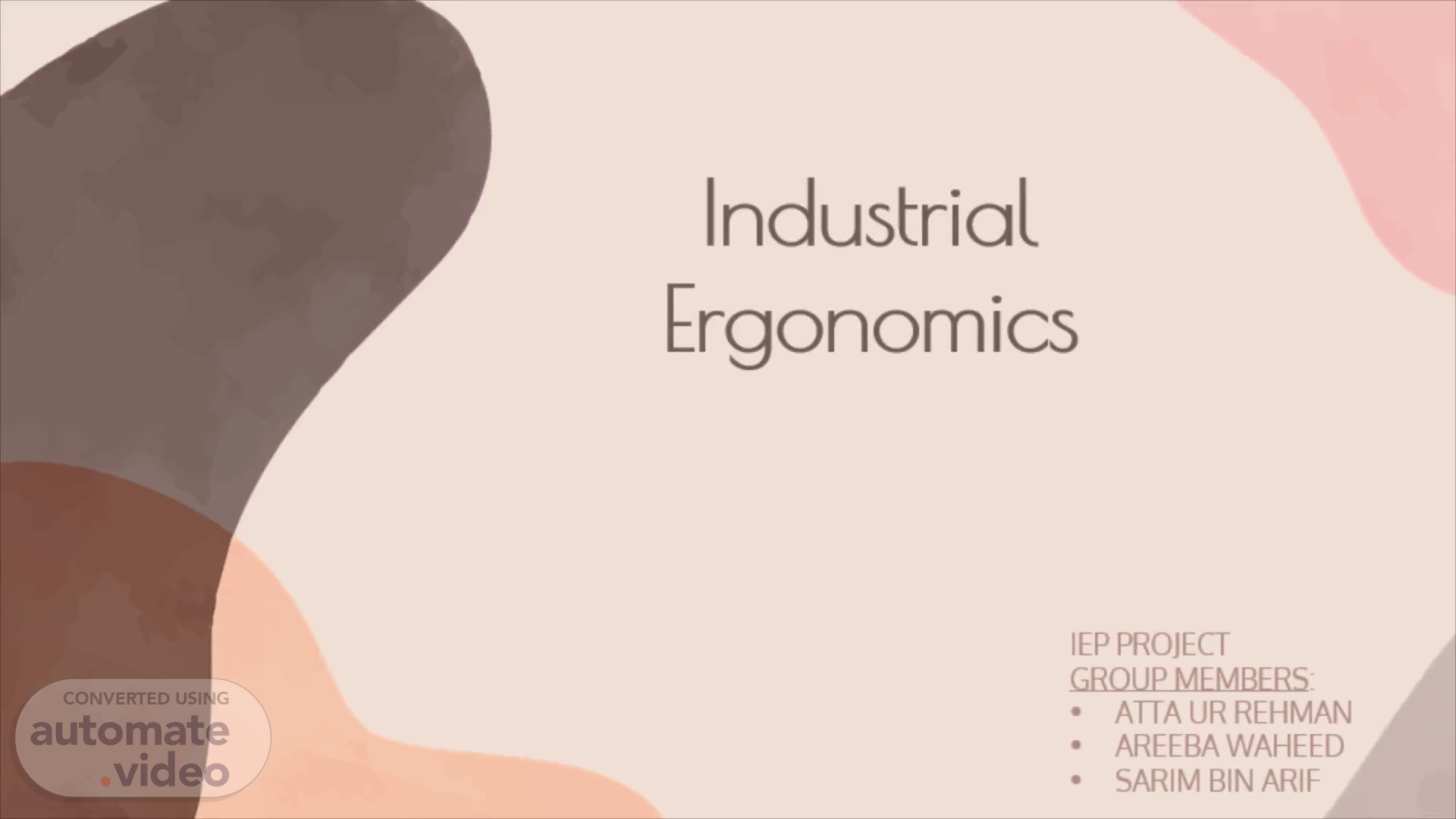
Industrial Ergonomics
Scene 1 (0s)
Industrial Ergonomics. IEP PROJECT GROUP MEMBERS : ATTA UR REHMAN AREEBA WAHEED SARIM BIN ARIF.
Scene 2 (8s)
Ergonomics “The scientific discipline concerned with understanding of interactions among humans and other elements of a system, and the profession that applies theory, principles, methods and data to design in order to optimize human well-being and overall system performance”.
Scene 3 (26s)
Overexertion leading cause of injuries Most costly Recurring/Persistent pain may develop in future Bodily reaction is another leading cause of injuries in workplace Repetitive motion also within top 10 most common workplace injuries Work Related Musculoskeletal Disorders (WMSDs) are fastest-growing injury/illness category (accounting for over 1.8 million annual lost workday cases in 1997 BLS stats). Up 600% over last 11 years $13 to 20 billion total injury cost / year & average $29 K / case compensation claim cost More lost workdays for RSIs (ave. = 30 days for a Carpal Tunnel injury).
Scene 4 (53s)
The association between occupations and musculoskeletal injuries was documented centuries ago. Bernardino Ramazinni (1633-1714) wrote about work-related complaints (that he saw in his medical practice) in the 1713 supplement to his 1700 publication, “De Morbis Artificum (Diseases of Workers).” Encouraged eventual passage of factory safety and workmen’s compensation Law. In 1700 he wrote De morbis artificum diatriba (Diseases of Workers) in Latin describing the health hazards of irritating chemicals, dust, metals, and other abrasive agents for workers in 52 occupations..
Scene 5 (1m 22s)
TYPES OF ERGONOMICS. PHYSICAL. COGNITIVE. ORGINIZATIONAL.
Scene 6 (1m 34s)
Physical Ergonomics Physical ergonomics is the most commonly known form of ergonomics, and for good reason. It deals with the physical load on the human body when performing activities. Knowing physical ergonomics and how to integrate it heavily influences on-site safety..
Scene 7 (2m 3s)
Organizational Ergonomics Organizational ergonomics combines the knowledge gained from other areas of the factory, like physical and cognitive ergonomics, to optimize safety and efficiency across the entire organization..
Scene 8 (2m 25s)
Musculoskeletal Disorders (MSDs) Affect the muscles, nerves, blood vessels, ligaments, and tendons Symptoms.
Scene 9 (2m 38s)
Repetitive Motion 63%. Repetitive Placing, Grasping, or Moving Objects 20%.
Scene 10 (2m 50s)
Carpal tunnel syndrome Low back pain. radiating-back-pain-nude-male.
Scene 11 (3m 2s)
Highest rate of missed days. Highest incident rate.
Scene 12 (3m 44s)
Train employees well. Reward employees for safe behavior Partner with occupational clinicians Use labels and signs Keep things clean Make sure employees have the right tools and have regular equipment inspections. Encourage stretch breaks Implement safety protocols from the start Keep an open dialogue Have regular meetings on workplace safety.
Scene 13 (4m 1s)
Change positions often; take stretch breaks Maintain neutral posture whenever possible Eliminate or reduce MSD risk factors Use material-handling aids Report MSD symptoms.
Scene 14 (4m 13s)
Determine whether MSD hazards exist and degree of risk Devise a control strategy with your input Implement control measures Training.
Scene 15 (4m 23s)
Install engineering controls including workstation layout and proper tools Institute work practice controls including neutral postures for performing tasks Administrative controls including rescheduling to reduce frequency or duration of exposure to MSDs Personal protective equipment (PPE) to provide a protective barrier between worker and MSD.
Scene 16 (4m 39s)
Job assessment MSD reporting and response system Designated coordinator Training Encourage employee participation and reporting of MSDs.
Scene 17 (4m 48s)
Ergonomists have a special place in every company or industry. For that reason every company provide jobs for ergonomists with an ample salary. Big companies provide a good salary to an ergonomist. Some are below;.
Scene 18 (5m 18s)
THIS IS A MAP. Pakistan. On an average in Pakistan an ergonomist earn between Rs. 35,000 to 55,000.
Scene 19 (5m 33s)
THANKS. The End.